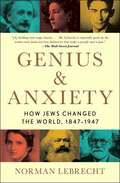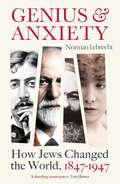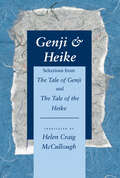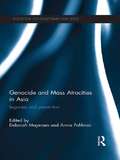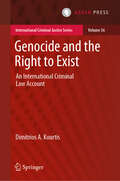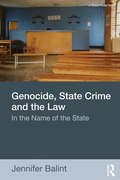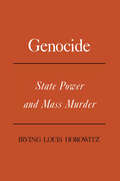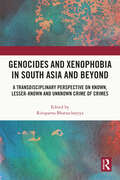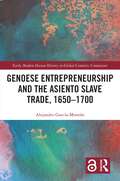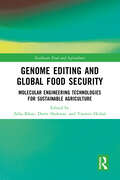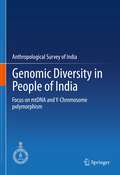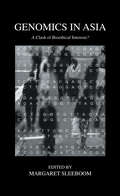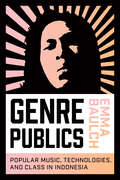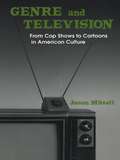- Table View
- List View
Genius & Anxiety: How Jews Changed the World, 1847-1947
by Norman LebrechtA unique chronicle of the years 1847-1947, the century when the Jewish people changed the world—and it changed them.In a hundred-year period, a handful of men and women changed the way we see the world. Many of them are well known—Marx, Freud, Proust, Einstein, Kafka. Others have vanished from collective memory despite their enduring importance in our daily lives. Without Karl Landsteiner, for instance, there would be no blood transfusions or major surgery. Without Paul Ehrlich, no chemotherapy. Without Siegfried Marcus, no motor car. Without Rosalind Franklin, genetic science would look very different. Without Fritz Haber, there would not be enough food to sustain life on earth. What do these visionaries have in common? They all had Jewish origins. They all had a gift for thinking in wholly original, even earth-shattering ways. In 1847 the Jewish people made up less than 0.25% of the world&’s population, and yet they saw what others could not. How? Why? Norman Lebrecht has devoted half of his life to pondering and researching the mindset of the Jewish intellectuals, writers, scientists, and thinkers who turned the tides of history and shaped the world today as we know it. In Genius & Anxiety, Lebrecht begins with the Communist Manifesto in 1847 and ends in 1947, when Israel was founded. This robust, magnificent volume, beautifully designed, is an urgent and necessary celebration of Jewish genius and contribution.
Genius and Anxiety: How Jews Changed the World, 1847–1947
by Norman LebrechtMarx, Freud, Proust, Einstein, Bernhardt and Kafka. Between the middle of the nineteenth and twentieth centuries a few dozen men and women changed the way we see the world. But many have vanished from our collective memory despite their enduring importance in our daily lives. Without Karl Landsteiner, for instance, there would be no blood transfusions or major surgery. Without Paul Ehrlich no chemotherapy. Without Siegfried Marcus no motor car. Without Rosalind Franklin genetic science would look very different. Without Fritz Haber there would not be enough food to sustain life on earth. These visionaries all have something in common – their Jewish origins and a gift for thinking outside the box. In 1847 the Jewish people made up less than 0.25% of the world&’s population, and yet they saw what others could not. How?
Genji & Heike: Selections from The Tale of Genji and The Tale of the Heike
by Helen Craig McCulloughThe Tale of Genji and The Tale of the Heike are the two major works of classical Japanese prose. The complete versions of both works are too long to be taught in one term, and this abridgement answers the need for a one-volume edition of both works suitable for use in survey courses in classical Japanese literature or world literature in translation and by the general reader daunted by the complete works. The translator has selected representative portions of the two texts with a view to shaping the abridgments into coherent, aesthetically acceptable wholes. Often called the world's earliest novel, The Tale of Genji, by Murasaki Shikibu, is a poetic evocation of aristocratic life in eleventh-century Japan, a period of brilliant cultural efflorescence. This new translation focuses on important events in the life of its main character, Genji. It traces the full length of Genji's relationship with Murasaki, the deepest and most enduring of his emotional attachments, and contains all or parts of 10 of the 41 chapters in which Genji figures, including the "Broom Tree" chapter, which provides a reprise of the themes of the book. In romanticized but essentially truthful fashion, The Tale of the Heike describes the late twelfth-century political intrigues and battlefield clashes that led to the eclipse of the Kyoto court and the establishment of a military government by the rival Minamotho (Genji) clan. Its underlying theme, the evanescence of worldly things, echoes some of the concerns of the Genji, but its language preserves many traces of oral composition, and its vigor and expansivelness contrast sharply with the pensive, elegant tone of the Genji. The selections of the Heike, about 40 percent of the owrk, are taken from the translator's complete edition, which received great acclaim: "this verison of the Heike is superb and indeed reveals to English-language readers for the first time the full scope, grandeur, and literary richness of the work."—Journal of Asian Studies For both the Genji and the Heike abridgments, the translator has provided introductions, headnote summaries, adn other supplementary maerials designed to help readers follow the sometimes confused story lines and keep the characters straight. The book also includes an appendix, a glossary, a bibliography, and two maps.
Genocide and Mass Atrocities in Asia: Legacies and Prevention (Routledge Contemporary Asia Series)
by Deborah Mayersen Annie PohlmanThe twentieth century has been labelled the ‘century of genocide’, and according to estimates, more than 250 million civilians were victims of genocide and mass atrocities during this period. This book provides one of the first regional perspectives on mass atrocities in Asia, by exploring the issue through two central themes. Bringing together experts in genocide studies and area specialists, the book looks at the legacy of past genocides and mass atrocities, with case studies on East Timor, Cambodia and Indonesia. It explores the enduring legacies of trauma and societal divisions, the complex and continuing impacts of past mass violence, and the role of transitional justice in the aftermath of mass atrocities in Asia. Understanding these complex legacies is crucial for the region to build a future that acknowledges the past. The book goes on to consider the prospects and challenges for preventing future mass atrocities in Asia, and globally. It discusses both regional and global factors that may impact on preventing future mass atrocities in Asia, and highlights the value of a regional perspective in mass atrocity prevention. Providing a detailed examination of genocide and mass atrocities through the themes of legacies and prevention, the book is an important contribution to Asian Studies and Security Studies.
Genocide and Mass Violence
by Devon E. Hinton Alexander L. HintonWhat are the legacies of genocide and mass violence for individuals and the social worlds in which they live, and what are the local processes of recovery? Genocide and Mass Violence aims to examine, from a cross-cultural perspective, the effects of mass trauma on multiple levels of a group or society and the recovery processes and sources of resilience. How do particular individuals recall the trauma? How do ongoing reconciliation processes and collective representations of the trauma impact the group? How does the trauma persist in 'symptoms'? How are the effects of trauma transmitted across generations in memories, rituals, symptoms, and interpersonal processes? What are local healing resources that aid recovery? To address these issues, this book brings into conversation psychological and medical anthropologists, psychiatrists, psychologists and historians. The theoretical implications of the chapters are examined in detail using several analytic frameworks.
Genocide and Victimology (Victims, Culture and Society)
by Yarin EskiGenocide and Victimology examines genocide in its diverse features, from different yet connected perspectives, to offer an interdisciplinary, victimological imagination of genocide. It will include in its exploration critical and cultural victimologies and criminologies of genocide, accompanied by, and recognising, the rich scholarship on genocide in the fields of religion and history, theatre studies and photography, philosophy and existentialism, post-colonialism, and ethnography and biography. Bringing together theory with empirical research and drawing on a range of case studies, such as the Treblinka extermination camp, the Bosnian and Rwandan genocides, the Sagkeeng First Nation in Manitoba, Canada, and genocidal violence in Syria and Iraq, this book engages the victimological imagination towards an interdisciplinary, cosmopolitan victimology of genocide. Bundled and intertwined, the wide yet integrated variety of perspectives on genocide gives readers a victimological kaleidoscope to discover, and for victimology hitherto, unexplored theory and methodology. This way, readers can develop their own more epistemologically, theoretically, and methodologically robust victimology of genocide—a victimology of genocide as envisioned by Nicole Rafter. The book hopes to canvas an understanding and a starting point for a diverse appreciation of genocide victimhood and survivorship from which the real post-genocidal harms and sites, post-traumatic stress disorder, courts and tribunals, and overall meaningful justice will benefit. Written in a clear and direct style, this book will appeal to students and scholars in criminology, sociology, cultural studies, philosophy, history, religious studies, English literature, and all those concerned with not repeating a history of genocide.
Genocide and its Threat to Contemporary International Order: Consent And The Controlled Body (New Security Challenges)
by A. GallagherFor far too long the discipline of International Relations has failed to engage with the study of genocide. This is despite the fact that genocide holds a direct relationship with the central concepts of international relations: the state, war, power, and security. This bold, innovative and unique book sets out to tackle this by bringing the concept of genocide into the discipline of IR, via the English School, in order to theorise the relationship between genocide, justice, and order. Drawing on a wide-range of primary and secondary interdisciplinary material from International Relations, Genocide Studies, Security Studies, International Law, History, Politics and Political Theory, this book aims to understand genocide within the context of International Relations and the implications that this has on policymaking. Gallagher identifies the obstacles and challenges involved in bringing the study of genocide into IR and uniquely analyses the impact of genocide on the ordering structure of international society.
Genocide and the Europeans
by Karen E. SmithGenocide is one of the most heinous abuses of human rights imaginable, yet reaction to it by European governments in the post-Cold War world has been criticised for not matching the severity of the crime. European governments rarely agree on whether to call a situation genocide, and their responses to purported genocides have often been limited to delivering humanitarian aid to victims and supporting prosecution of perpetrators in international criminal tribunals. More coercive measures - including sanctions or military intervention - are usually rejected as infeasible or unnecessary. This book explores the European approach to genocide, reviewing government attitudes towards the negotiation and ratification of the 1948 Genocide Convention and analysing responses to purported genocides since the end of the Second World War. Karen E. Smith considers why some European governments were hostile to the Genocide Convention and why European governments have been reluctant to use the term genocide to describe atrocities ever since.
Genocide and the Right to Exist: An International Criminal Law Account (International Criminal Justice Series #36)
by Dimitrios A. KourtisThis book delves into the complexities of genocide as a legal concept, offering a fresh perspective by exploring the rights of groups to exist under international criminal law. It presents an in-depth analysis of group rights, challenging traditional interpretations within the context of the Genocide Convention. By focusing on the conceptual and practical implications of recognizing groups as rights-holders, this work introduces a nuanced understanding of collective rights and their enforcement. What sets this approach apart is its thorough examination of both the theoretical foundations and the operational aspects of international law concerning genocide. The book provides a critical assessment of various legal theories, addressing how these can be reconciled with the dynamic nature of international human rights practices. It also highlights the potential for these theoretical frameworks to impact the protection of vulnerable groups on a global scale. The scope of this work is broad yet detailed, encompassing an analysis that will be invaluable for legal practitioners, scholars, and policymakers. It systematically addresses the ambiguities and challenges in defining and prosecuting genocide, offering strategic insights into the enhancement of legal frameworks to prevent such atrocities. The book incorporates primary archival research that brings to light new evidence on the drafting of the Genocide Convention, including cases such as that of the Greek children, which have previously been underexplored. The primary audience for the work includes academics and students in the fields of international law, international criminal law, criminal law, human rights, and genocide studies, as well as diplomats, policy-makers, legal professionals, historians, sociologists, anthropologists, philosophers specializing in genocide, and genocide scholars in general. The insights provided will be crucial for anyone committed to advancing the understanding and implementation of international law protecting group rights. Dimitrios Kourtis holds a PhD and is a Post-doctoral Researcher and Teaching Fellow in the Department of International Studies at the Faculty of Law of the Aristotle University in Thessaloniki, Greece.
Genocide of Indigenous Peoples: A Critical Bibliographic Review (Genocide: A Critical Bibliographic Review Ser.)
by Samuel Tottena and Robert K. HitchcockAn estimated 350 to 600 million indigenous people reside across the globe. Numerous governments fail to recognize its indigenous peoples living within their borders. It was not until the latter part of the twentieth century that the genocide of indigenous peoples became a major focus of human rights activists, non-governmental organizations, international development and finance institutions such as the United Nations and the World Bank, and indigenous and other community-based organizations. Scholars and activists began paying greater attention to the struggles between Fourth World peoples and First, Second, and Third World states because of illegal actions of nation-states against indigenous peoples, indigenous groups' passive and active resistance to top-down development, and concerns about the impacts of transnational forces including what is now known as globalization. This volume offers a clear message for genocide scholars and others concerned with crimes against humanity and genocide: much greater attention must be paid to the plight of all peoples, indigenous and otherwise, no matter how small in scale, how little-known, how "invisible" or hidden from view.
Genocide, State Crime and the Law: In the Name of the State
by Jennifer BalintGenocide, State Crime and the Law critically explores the use and role of law in the perpetration, redress and prevention of mass harm by the state. In this broad ranging book, Jennifer Balint charts the place of law in the perpetration of genocide and other crimes of the state together with its role in redress and in the process of reconstruction and reconciliation, considering law in its social and political context. The book argues for a new approach to these crimes perpetrated 'in the name of the state' - that we understand them as crimes against humanity with particular institutional dimensions that law must address to be effective in accountability and as a basis for restoration. Focusing on seven instances of state crime - the genocide of the Armenians by the Ottoman state, the Holocaust and Nazi Germany, Cambodia under the Khmer Rouge, apartheid South Africa, Ethiopia under Mengistu and the Dergue, the genocide in Rwanda, and the conflict in the former Yugoslavia - and drawing on others, the book shows how law is companion and collaborator in these acts of nation-building by the state, and the limits and potentials of law's constitutive role in post-conflict reconstruction. It considers how law can be a partner in destruction yet also provide a space for justice. An important, and indeed vital, contribution to the growing interest and literature in the area of genocide and post-conflict studies, Genocide, State Crime and the Law will be of considerable value to those concerned with law's ability to be a force for good in the wake of harm and atrocity.
Genocide: State Power and Mass Murder (Issues In Contemporary Civilization Ser.)
by James BaldwinThis book is dedicated to a consideration of genocide in the context of political sociology. It demonstrates that the underlining predicates of sociology give scant consideration to basic issues of life and death in favor of distinctly derivative issues of social structure and social function.
Genocides and Xenophobia in South Asia and Beyond: A Transdisciplinary Perspective on Known, Lesser-known and Unknown Crime of Crimes
by Rituparna BhattacharyyaThis volume foregrounds some of the unknown or lesser-known incidents of xenophobia and genocide from India, Bangladesh, Sri Lanka, South Africa, and Rwanda. It critically analyses the cultural and structural contexts triggering these various forms of genocides and xenophobia, and situates them within modern histories of violence and human tribulations. The book discusses various non-western case studies which include the communal violence incited by anti-CAA protests in Delhi; the expulsion and displacement of Kashmiri Pandits; xenophobic attitudes against illegal immigrants in Assam; genocide in Sylhet during the Liberation War of Bangladesh; the 1994 genocide in Rwanda; and incidences of human rights violations across the world. A comprehensive and transdisciplinary text, the book will be useful for students and researchers of human geography, sociology, political science, social work, anthropology, colonialism and postcolonialism, nationalism, imperialism, human rights, and history.
Genoese Entrepreneurship and the Asiento Slave Trade, 1650–1700 (Early Modern Iberian History in Global Contexts)
by Alejandro García-MontónThis book explains how Genoese entrepreneurs transformed the structures of global trade during the second half of the seventeenth century. The author reconstructs the business network built by the Genoese merchant Domenico Grillo between the 1650s and the 1680s. Grillo’s business interests stretched from the Mediterranean to Pacific South America, traversing and joining the Spanish, Dutch, and English Atlantics. He and his associates created a new business model that was to be emulated by Dutch, French, and English traders in subsequent decades: the monopolistic asientos for the exploitation of the trans-imperial and intra-American slave trade to Spanish America. Offering a connected history of capitalism across trans-continental geographies and different empires, this book challenges established views of a period which has traditionally been interrogated from a northern European mercantile perspective. Cutting across the histories of the slave trade in the Atlantic world, early modern capitalism, and early modern empire, this study has much to offer to students and scholars interested in the agents, economic practices, and geographies of trade that do not easily fit into and therefore disrupt the traditional narratives of the Rise of the West.
Genoese Trade and Migration in the Spanish Atlantic, 1700–1830
by Catia BrilliThe Republic of Genoa was once a major commercial power. Following the Republic's decline in the seventeenth century, Genoese merchants adapted and thrived in the changing Atlantic market. Scholars have examined how other foreign merchant groups operated within the Spanish empire, but until now no one has examined how the Genoese adapted to the challenges of increasing competition in Atlantic trade. Here, Catia Brilli explores how Genoese intermediaries maintained a strong presence in Spanish colonial trade by establishing themselves at the port of Cadiz with its monopoly over American trade, and through gradually consolidating strong commercial ties with the R#65533;o de la Plata. Situated at the intersection of European, Atlantic, and Latin American history and making extensive use of Spanish, Italian, and Argentinian sources, Genoese Trade and Migration in the Spanish Atlantic, 1700–1830 provides a unique perspective on eighteenth- and early nineteenth-century transatlantic trade.
Genome Editing and Global Food Security: Molecular Engineering Technologies for Sustainable Agriculture (Earthscan Food and Agriculture)
by Zeba Khan Durre Shahwar Yasmin HeikalWith the rapid increase in the global population and changing climatic impacts on agriculture, this book demonstrates how genome editing will be an indispensable technique to overcome ongoing and prospective agricultural challenges. This book examines the role of genome editing in improving crop yields and contributing to global food security. It summarizes a range of genome editing techniques and discusses the roles they can play in producing a new generation of high-yielding, climate-ready crops. This includes site-specific nucleases, precision genome engineering, clustered regularly interspaced short palindromic repeats, and bioinformatics. It showcases how these gene editing techniques can tailor plants to not only increase yield-related traits but to also make them better suited to their environment and to be resistant to pests and extreme climatic events, such as droughts. The book also examines genome editing regulations and policies, the commercialization of genome-edited crops, and biosafety and biosecurity concerns. Overall, this book reveals and showcases how genome editing can improve crop resilience and production to address current and future agricultural challenges and alleviation of global food security concerns. This book will be of great interest to students and scholars of agricultural science, crop and plant science, genome editing, sustainable agriculture, biotechnology, and food security.
Genomic Diversity in People of India: Focus on mtDNA and Y-Chromosome polymorphism
by Anthropological Survey Of IndiaThis book is the output of Anthropological Survey of India's National Project "DNA Polymorphism of Contemporary Indian Population" conducted during 2000 to 2018. The book compiles the independent and collaborative work of 49 scientific personnel. Genomics facilitate the study of genetic constitution and diversity at individual and population levels. Genomic diversity explains susceptibility, predisposition and prolongation of diseases; personalized medicine and longevity; prehistoric demographic events, such as population bottleneck, expansion, admixture and natural selection. This book highlights the heterogeneous, genetically diverse population of India. It shows how the central geographic location of India, played a crucial role in historic and pre-historic human migrations, and in peopling different continents of the world. The book describes the massive task undertaken by AnSI to unearth genomic diversity of India populations, with the use of Uni-parental DNA markers mtDNA (mitochondrial DNA) and Y –chromosome in 75 communities. The book talks about the 61 maternal and 35 paternal lineages identified through these studies. It brings forth interesting, hitherto unknown findings such as shared mutations between certain communities. This volume is a milestone in scientific research to understand biological diversity of Indian people at genomic level. It addresses the basic priority to identify different genes underlying various inborn genetic defects and diseases specific to Indian populations. This would be highly interesting to population geneticists, historians, as well as anthropologists.
Genomics In Asia
by Margaret Sleeboom-Faulkner"Genomics in Asia" focuses on issues dealing with the development and application of molecular biology and bioengineering technologies in Asian societies and cultures. The workshop on which this book is based aimed to gain an insight into bioethical issues with relation to the dynamics of Asian societies, cultures and religions. It was to generate debate on Asian Genomics and create a basis for comparative research into the relationship between the development and application of modern genetics, cultural values, and local interests in Asian societies. The papers first of all reflect a great variety of bioethical views discussed from the angle of different disciplinary and cultural backgrounds, creating a basis on which a further comparison between different local knowledge systems in relation to genomic practices will be feasible. This book provides insights on research into the social, political and ethical aspects of genomics, and reflects the bioethical experiences of researchers from Japan, China, the Philippines, Thailand, Taiwan, Pakistan, India and Malaysia. The subjects of discussion vary from genetics in China to religious perspectives on cloning and genetic therapy. Themes include the commercial and medical application of new bioengineering technologies, such as the impact of preventive genetic medicine, genetic counselling, genetically modified organisms [GMOs] and stem-cell research on wealth distribution, cultural traditions, social well-being, and political and legal regulations and institutions. In the study of bioengineering in Asia, various perspectives were brought together at a concrete research level. The authors tried to avoid macro-concepts incorporated by dichotomies of East and West and to acquire new insights into the relationship between local knowledge systems and cultures and interests groups on the one hand and the constellation of various interests of scientific research, governments and MNCs on the other.
Genre And Video Game: Introduction To An Impossible Taxonomy
by Felix SchnizThis monograph explains video games as multidimensional and deeply mutable concepts as the interplay of three dimensions: Indeed, in addition to the hybrid approaches between genre of fiction and genre of game in genre theory, it is also social genre complexes that shape the experience of the player, especially in multiplayer games. The video game reveals itself as an objet ambigué: an art object that finally reveals and repositions itself in the process of interaction with the user.
Genre Knowledge in Disciplinary Communication: Cognition/culture/power
by Carol Berkenkotter Thomas N. HuckinAlthough genre studies abound in literary criticism, researchers and scholars interested in the social contexts of literacy have recently become interested in the dynamic, rhetorical dimensions of speech genres. Within this burgeoning scholarly community, the authors are among the first researchers working within social science traditions to study genre from the perspective of the implicit knowledge of language users. Thus, this is the first sociocognitive study of genre using case-study, naturalistic research methods combined with the techniques of rhetorical and discourse analysis. The term "genre knowledge" refers to an individual's repertoire of situationally appropriate responses to recurrent situations -- from immediate encounters to distanced communication through the medium of print, and more recently, the electronic media. One way to study the textual character of disciplinary knowledge is to examine both the situated actions of writers, and the communicative systems in which disciplinary actors participate. These two perspectives are presented in this book. The authors' studies of disciplinary communication examine operations of systems as diverse as peer review in scientific publications and language in a first grade science classroom. The methods used include case study and ethnographic techniques, rhetorical and discourse analysis of changing features within large corpora and in the texts of individual writers. Through the use of these techniques, the authors engaged in both micro-level and macro-level analyses and developed a perspective which reflects both foci. From this perspective they propose that what micro-level studies of actors' situated actions frequently depict as individual processes, can also be interpreted -- from the macro-level -- as communicative acts within a discursive network or system. The research methods and the theoretical framework presented are designed to raise provocative questions for scholars, researchers, and teachers in a number of fields: linguists who teach and conduct research in ESP and LSP and are interested in methods for studying professional communication; scholars in the fields of communication, rhetoric, and sociology of science with an interest in the textual dynamics of scientific and scholarly communities; educational researchers interested in cognition in context; and composition scholars interested in writing in the disciplines.
Genre Publics: Popular Music, Technologies, and Class in Indonesia (Music / Culture)
by Emma BaulchGenre Publics is a cultural history showing how new notions of 'the local' were produced in context of the Indonesian 'local music boom' of the late 1990s. Drawing on industry records and interviews, media scholar Emma Baulch traces the institutional and technological conditions that enabled the boom, and their links with the expansion of consumerism in Asia, and the specific context of Indonesian democratization. Baulch shows how this music helped reshape distinct Indonesian senses of the modern, especially as 'Asia' plays an ever more influential role in defining what it means to be modern.
Genre Studies in Mass Media: A Handbook
by Art SilverblattThe study of various types of programming is essential for critical analysis of the media and also offers revealing perspectives on society's cultural values, preoccupations, behavior, and myths. This handbook provides a systematic, in-depth approach to the study of media genres - including reality programs, game shows, situation comedies, soap operas, film noir, news programs, and more. The author addresses such questions as: Have there been shifts in the formula of particular genres over time? What do these shifts reveal about changes in culture? How and why do new genres - such as reality TV shows - appear? Are there differences in genres from one country to another? Combining theoretical approaches with concrete examples, the book reinforces one's understanding of the importance of genre to the creation, evolution, and consumption of media content. Each chapter in this reader-friendly book contains a detailed discussion of one of the theoretical approaches to genre studies, followed by Lines of Inquiry, which summarizes the major points of the discussion and suggests directions for analysis and further study. Each chapter also includes an example that illustrates how the particular theoretical approach can be applied in the analysis of genre. The author's careful linkage of different genres to the real world makes the book widely useful for those interested in genre study as well as media and culture, television studies, film studies, and media literacy.
Genre and Cinema: Ireland and Transnationalism (Routledge Studies in Cultural History)
by Brian McIlroyThis impressive volume takes a broad critical look at Irish and Irish-related cinema through the lens of genre theory and criticism. Secondary and related objectives of the book are to cover key genres and sub-genres and account for their popularity. The result offers new ways of looking at Irish cinema.
Genre and Hollywood (Sightlines)
by Steve NealeGenre and Hollywood provides a comprehensive introduction to the study of genre. In this important new book, Steve Neale discusses all the major concepts, theories and accounts of Hollywood and genre, as well as the key genres which theorists have written about, from horror to the Western. He also puts forward new arguments about the importance of genre in understanding Hollywood cinema.Neale takes issue with much genre criticism and genre theory, which has provided only a partial and misleading account of Hollywood's output. He calls for broader and more flexible conceptions of genre and genres, for more attention to be paid to the discourses and practices of Hollywood itself, for the nature and range of Hollywood's films to be looked at in more detail, and for any assessment of the social and cultural significance of Hollywood's genres to take account of industrial factors.In detailed, revisionist accounts of two major genres - film noir and melodrama - Neale argues that genre remains an important and productive means of thinking about both New and old Hollywood, its history, its audiences and its films.
Genre and Television: From Cop Shows to Cartoons in American Culture
by Jason MittellGenre and Television proposes a new understanding of television genres as cultural categories, offering a set of in-depth historical and critical examinations to explore five key aspects of television genre: history, industry, audience, text, and genre mixing. Drawing on well-known television programs from Dragnet to The Simpsons, this book provides a new model of genre historiography and illustrates how genres are at work within nearly every facet of television-from policy decisions to production techniques to audience practices. Ultimately, the book argues that through analyzing how television genre operates as a cultural practice, we can better comprehend how television actively shapes our social world.
